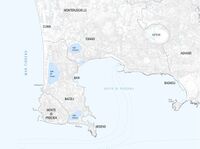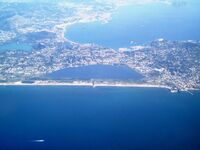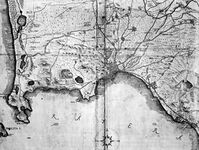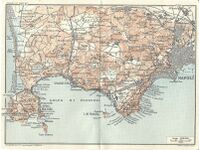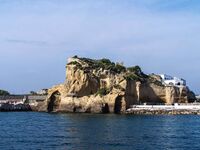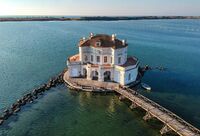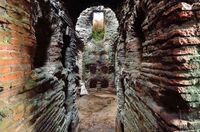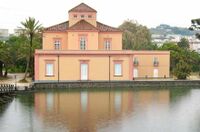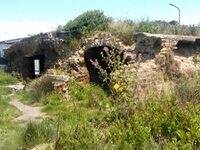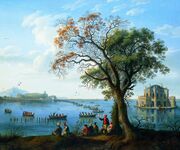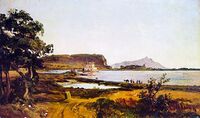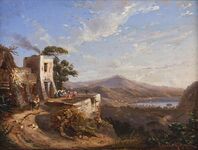Fusaro Lake WAVE Living Lab 2021
>>>back to working groups overview
Rationale
- As a part of the Phlegraean Fields, Fusaro Lake and its surroundings represent a cultural legacy for the mediterranean civilization, testified by greek mythology and history. Therefore archeological sites, which represent this heritage, should be enhanced as cultural goods.
- Thanks to its volcanic nature, this landscape owns different resources that constitute an opportunity for territory productive and economic developments.
- Biodiversity plays a key role in the management of the area and it should be protected and highlighted. Pollution and abusive settlements should be adressed and regulated before unsustainable development degrades ecosystems.
Location and scope
You can edit this map with the map editor
Water as a natural system
Geomorphology, typologies and dynamics of water areas
- Describe the water areas of your area in the context of the wider water system
Fusaro Lake belongs to the Phlegraean Fields, a geographical area located in the Gulf of Pozzuoli, in the northwestern part of the city of Naples and its gulf, famous since ancient times for its vigorous volcanic activity, consisting of a large caldera in state of quiescence with a diameter of 12–15 km. The Phlegraean territory is characterized by numerous lake formations of volcanic origin (Lake Averno, Lake Lucrino) and coastal lakes generated by barrage (Lake Fusaro, and Lake Miseno).
• Averno Lake, enclosed between steep wooded slopes, has a surface area of 0.55 square km and a maximum depth of 34 m. it lies within an extinct volcanic crater, born 4,000 years ago. In fact, even the poet Virgil in the sixth book of the Aeneid places near this lake the mystical entrance to the Underworld.
• Lucrino Lake is currently located on the bottom of a volcanic crater very close to the coast, but it is not exactly of volcanic origin. Initially it was part of the coast from which it then moved away by forming an isthmus due to the continuous movement of the wave motion.
• Miseno Lake has an extension of more than 40 hectares and a perimeter of about 2,800 meters while the average depth is 2.25 meters and the maximum depth of 4. It is separated from the sea by a sandy barrier about 200 meters wide but is connected with it. through two mouths: the first located near the town of Miliscola and the second located near the bay of Miseno.
• Fusaro Lake is the largest of the Phlegraean lakes, located close to the Torregaveta promontory, separated from the coast by a thin strip of sand. The lake was formed with the closure of the stretch of sea through a tongue of land. Its perimeter measures approximately 4.10 km and has an area of 0.97 square km. It is characterized by brackish water, two channels were built to facilitate the exchange of water, one from the Romanesque period and one from the 18th century.
- How does water appear in the landscape of your living lab? What types of water areas are common?
Water management of Fusaro lake and its surroundings appear disregarded, especially Water Caves (Grotte dell’Acqua). The ancient thermal cisterns are in a state of severe neglect. Instead, Lake fusaro, the richest and largest of all the Phlegraean lakes, has a medium pollution rate caused by the increase of temperatures and is favored by not healthy water conditions. The boom in algal bloom, in general, according to biologists, would also be encouraged by pollutants. The mucilage, in fact, a natural phenomenon exacerbated by poor oxygenation of the water, would be affected by the presence of particular nutrients introduced by man.
- Please identify the water bodies' catchment areas, tributaries and floodplains
- Which dynamics do these water areas have?
Lake Fusaro consists of 98 hectares of lake surface and a total extension of 135 hectares. It still preserves stretches of reeds on the banks, however, mostly embanked and cemented, on which the old park stands, which enriches the arboreal endowment. it is connected to the sea by three channels, and inside it is practiced the breeding of fish and molluscs. The lake was exploited for the breeding of mussels and oysters by the Greek and Roman populations who had built splendid villas in its ravines. At that time, in fact, the lake did not yet exist and the area appeared as a large gulf. Only after the first century A.D. a sandy strip formed due to the scarce ebb of the tides transformed it into a lagoon and therefore into a coastal lake. In Water Caves, instead, despite the presence of a gate to protect the archaeological site, garbage and clothing lie in the rooms of the ancient baths. The waters that rise from the subsoil have a temperature of about 40 ° and are rich in minerals equal to those that arise in Ischia ". In Ischia these waters," miraculous for the ancient Romans, of great value for the Bourbons ", are appreciated by tourists and sponsored: in the Fusaro park "Grotte dell’Acqua" are abandoned and a few days ago a piece of the vault also fell. Ferdinand 4 of Bourbon had great consideration for these archaeological sites.
- Have there been any flood events in the past?
The territory of Lake Fusaro is often characterized by flash floods causing numerous damage every year. The major recent flood events are those of 2011 and 2017 which recorded rainfall values exceeding 100 mm in a single day.
- add 2-3 graphical representations to the image gallery, you can add more if you like
- Immagine 1.jpg.jpg
Future cycle-pedestrian area
Water as a living space
- Which habitats can be found in and along the water areas of your area?
On site, 40 percent of the area owns habitats in a good or excellent state of conservation. On the remaining part, habitats are in a good to poor state of conservation. This phenomenon is due to a strong presence and anthropogenic pressure. Moreover, the soil use spatial distribution enhances this evolution as naturalized areas are mixed with agricultural lands. This territory fragmentation disrupts forest and coastal environment. Regarding fauna, local species are endangered by predators such as cats and dogs and more specially during nesting periods. Regarding flora, meadow habitats can be found on the surroundings of Fusaro lake. This kind of vegetation was maintained by mowing or grazing activities. Depending on the state of abandonment these habitats are slowly and naturally evolving towards more mature forms of shrub vegetation. More precisely, Fusaro lake was used for aquaculture during the roman era and it still hosts cultures of fish and mussels. Today, is affected by the artificialization of most of the banks, by the presence of mussel’s intensive cultivation and various sewage discharges. However, reeds can be found alongside cemented banks and tall trees testified the presence of an old park. On the sand coast a typical Mediterranean maquis shrubland is well preserved despite the arrival of a new mouth.
- How is the water quality in your water areas?
Regarding marine bathing in Bacoli, it is considered excellent. Despite this, in this area for years environmental pollution, the lack of infrastructure - especially the sewer system - and an old purifier, have blocked economic development and conditioned the daily life of thousands of people. Bacoli has only three non-bathing areas among its beaches, fortunately. All on the Roman beach: Lido P.S, Colonia Vescovile and Lido Fusaro. The waters of the canals are polluted by illegal civil, industrial and agricultural-zootechnical discharges that cause widespread pollution that is not under control. The illegal discharge was eliminated only in 2020, and due to its presence for over 10 years, it has contributed significantly to polluting the waters of the lake and of the sea.
- Which areas are still natural, which are urbanised/artificial?
The site has a typical formation of a strongly anthropised retrodunal lake both along the edge of the lake on the eastern side and in the belt separating the dune-backdune from the sea. The morphology of the coast, the presence of the sea, the various productive activities linked to the lake since the Roman period, have encouraged the exercise of economic activities in the area. The site has undergone intense anthropogenic pressure mainly linked to the construction of buildings for residential purposes, many of them are likely to be illegal. Today agricultural activity plays a very niche role in the local economy. The lower practice of traditional activities was accompanied by a reduction in the number of employees in the primary sector and leading to a decrease in actively managed areas. This entailed the maintenance of niche agricultural activities linked to tourist reception facilities, and conversely the construction of bathing establishments that have involved a strong compromise of the dune and back dune belt where today you can read sparse strips of what was the expanse of scrub and holm oak. In recent years, illegal dumping and burial of waste in agricultural areas have been reported. The properly urbanized areas are outside the borders of the site, but within them there are numerous episodes of construction, including conspicuous ones, many of which are illegal. Particular attention must be paid to water and sewage discharges, which are evidently present. At the borders of the area there is the industrial settlement of Alenia whose production processes should be monitored. Illegal dumps of asbestos have also been reported along the municipal road around the sea side.
- Are the rivers permeable for fish or blocked by artificial elements?(approx 200 signs)
The lake is unsuitable for fish survival due to its brackish nature. It was once known for the cultivation of mussels, whose fishing is now prohibited due to the heavy pollution of the waters. The lake communicates with the sea through three mouths:
• The first to the south, called Foce Vecchia or Romana, is located near Torregaveta, has an 800 m long mouth channel with a span of 5.5 m and a depth of <1m;
• The second in the center of the reservoir is called the Foce di Mezza Chiara, and connects the lake and the sea with a 500m long canal with a span of 10.6m and a depth of 1m;
• The third northernmost mouth, Foce Nuova, has a 700 m long outlet channel, a span of 10.6 m and a depth of 1m;
The flow rate on each channel is regulated by a series of double gates which are in a serious state of neglect, which has led to a worsening of the water conditions of the lake.
- add 1-2 graphical representations to the image gallery, you can add more if you like
- Yourcase wateraslivingspace1.jpg
add a caption
- Yourcase wateraslivingspace2.jpg
add a caption
Blue and Green Infrastructure
- What are the major potential elements of a green/blue infrastructure network? Are these likely to change/disappear? Why is that?
- You find my background material on green infrastructure in our reading list
- add 1-2 graphical representations to the image gallery, you can add more if you like
- Your case green blue infrastructure1.jpg
add a caption
- Your case green blue infrastructure2.jpg
add a caption
Water as a cultural space
Land use and water
- map the land uses along your water areas: settlements, infrastructure, agriculture, resource extraction, natural areas, energy production...
- In Image 1 and in Image 2 is clear as Bacoli is divided into different areas:
- Residential areas (mainly civil and rural buildings);
- Agricultural areas (vineyards, orchards, greenhouses, arable land, wooded areas);
- Natural areas (parks and reserves);
- Industrial area;
- Touristic area;
- Infrastructures (road network, rail system, harbour system);
- Equipment (parking areas, schools, public and sports buildings).
- describe in particular the historical evolution of land use pattern, please make use of historical maps
- Bacoli was founded by the ancient Romans who called it “Bauli”. During the Augustan age it became the main military outpost and, together with Baieae, the political and cultural capital city. From the II century to the IV century the Romans built a lot of luxurious villas full of marble and mosaics. They took advantage of the territory and of the thermal waters’ therapeutic power. They also built bridges and pools to connect different parts of the city. Following the fall of the Roman Empire, Bacoli lapsed because of two phenomena:
- Geological issues like bradisism and erosions;
- The Barbarian invasions.
During 1600 a group of neapolitan Jews gave rebirth to the city by farming and fishing. Until the middle of the XVIII century Fusaro lake was used for mussels and oysters cultivation and for hunting. Ferdinando IV of Bourbon built his royal casina upon a lake small island. Successively the city became one of the favourite destinations for the europeans. Starting from 1850 there is a massive demographic growth which brought an increasement of the residential settlements, this phenomenous continued during 1900 especially with the building speculations of 1970. Today in Bacoli there are mainly residential buildings and agricultural areas, the coast is used as a bathing area.
- description evolution, status quo and driving forces, is the land use likely to change? Why is that? (approx 200 signs)
- add 1-2 graphical representations to the image gallery, you can add more if you like
Cultural and spatial typologies of water areas
- Which spatial patterns have evolved in relation to your water areas?
- What is the role of water areas within the overall urban morphology? (approx 200 signs)
- add 1-2 graphical representations to the image gallery, you can add more if you like
- Yourcase water space1.jpg
add a caption
- Yourcase water space2.jpg
add a caption
- Yourcase water space3.jpg
add a caption
Sacred spaces and heritage
- Which places/elements hold cultural value and to whom?
As a part of the Phlegraean Fields, Fusaro Lake area has got many cultural places, sometimes they are not even known from the population of Bacoli itself, but they constitute an important heritage for the mediterranean civilization.
- CERBERUS CAVERN
The name "Cerberus cavern" comes from the fact that Virgil probably took his inspiration from this place to describe the entrance to the Underworld of which Cerberus was the guardian. Between the II and I centuries B.C., the roman “nobiles” built villas and thermal baths near to Fusaro Lake, the most famous one was Servilio Vatia’s domus. According to some historical record the mouth of the Cerberus cave was used as a tunnel connecting the landing and the part behind of Publio Servilio’s villa. Successively, because of the morphological concerns caused by bradisism, it has been linked to Fusaro Lake.
- VILLA SERVILIO VATIA
Today only some rests of Publio Servilio Vatia's (roman commander and poltician) villa remains, some of them are visible and other ones are incorporated into a restaurant. The villa was so beautiful that the Romans used to say: “O Vatia, tu solus scis vivere” (= “Oh vatia, only you know how to live”). The domus was erected between the end of the Republican age and the Augustan age, it was built upon a tufaceous rocky spur overworking the natural structure of the ground and using artificial substructions to ensure that the villa was distributed in terraces. This position allowed the owners and their guests to enjoy the sea breeze and the sun which heated the environment in winter.
- CASINA VANVITELLIANA
The Casina Vanvitelliana is an evocative little house located on a little island of Fusaro Lake. In 1752 Fusaro area, at the time mostly inhabited, became the hunting and fishing reserve of the Bourbons, who hired Luigi Vanvitelli for the first works for the transformation of the place. When Ferdinando IV ascended to the throne, the interventions were completed by Carlo Vanvitelli, Luigi's son, who in 1782 created the Royal Casino of Hunting on the lake, not far from the shore. This building, known as Casina Vanvitelliana, was used as the residence for important guests, such as Francis II of Habsburg-Lorraine. Inside the building were also welcomed Wolfgang Amadeus Mozart, Gioachino Rossini and, more recently, the President of the Republic Luigi Einaudi. From an architectural point of view, the Casina is one of the most refined eighteenth-century productions, with something that is similar to the conformation of the hunting lodge, designed a few years before by Filippo Juvarra using plastic volumes and large windows. The building commissioned by the Bourbons in fact has a very articulated plan, composed of three octagonal bodies that intersect one at the top of the other, as a sort of pagoda, with large windows arranged on two levels; in addition a long wooden bridge connects the Casina to the lake shore.
- SALA OSTRICHINA
In 1817, on the shores of Lake Fusaro, a new building called the Ostrichina was built. It was in front of the Casina Vanvitelliana, based on a project by the court architect Antonio de Simone. The building’s name derives from the baskets for oyster farm of the Fusaro lake to which the Ostrichina was connected. In 1853 the building, originally with a central plan and smaller than it is today, was used as a restaurant, and in 1885 it was renovated and reopened to the public. By the end of the 19th century the building was increased by a two-level building, assuming the planimetric "L" shape given by the aggregation of the two bodies subsequently added. Furthermore, the particular planimetric conformation has suggested the creation of a large room with marble flooring that gives grandeur to the unitary space of the room. Today it is not open to the public except on rare occasions for conventions, concerts, exhibitions and public meetings.
- FUSARO COLUMBARIUM
The funerary complex known as the Columbarium in Via Virgilio is located in a public area: it consists of a series of rooms at street level and an underground building of the columbarium type. In the original project the rooms, made of bricks and reticulate, didn’t have a funeral destination but were used as a meeting place for the celebration of the deceased. The construction of the complex has spanned different phases, from the end of the I century. B.C. until the II century. A.C when the definitive complex was built. The latter included rooms on the upper level used for burials and for inhumation. During the III century A.C, in this complex were found 11 funerary epigraphs. The earliest information referring to the Fusaro mausoleum dates back to 1841 when the Kingdom of the Two Sicilies’s architect Carlo Bonucci explored the complex, finding three funerary epigraphs inside burial tombs. After more than a century, in which the site was used as an arsenal and then as a landfill, a new intervention was carried out by a working group coming from the Municipality of Bacoli. They excavated other burials, returning eight other funerary epigraphs that were discovered.
- WATER CAVES
The water caves on the shores of Fusaro Lake are the remains of thermal cisterns from the Imperial Roman age. In the past they were annexed to a Roman villa behind them, in fact they were rich in ornamental paintings and stuccos that are now disappearing. The caves, until 1950 were used as a healing place for local people. The waters that flow from the subsoil of the water caves were considered "miraculous" by the ancient Romans and by the Bourbons, among the first to restore and protect them, in fact, these waters have a temperature of about 40 ° C and are rich in minerals beneficial, similar to those that flow on the island of Ischia, where they are appreciated by tourists. In 1998, the archaeological site was the subject of new investigations, research and redevelopment; an intervention that unfortunately remained incomplete. For years the caves have been in a state of decay but various associations are involved in the protection and relaunch of this important archaeological site.
Visual appearance and landscape narrative
- Which elements are essential for the landscape character?
- Has the landscape been painted or otherwise depicted, when and whom? Which elements are essential?
- Which narratives exist? Who has written about this landscape or depicted it in some way?
- You can add text and images
The landscape of Bacoli is a very fragmented territory, characterized since always by a strong natural matrix. Fields, agriculture and water make it a fascinating and complex place. Water is the predominant element, present in many shapes: brackish water of the Tyrrhenian Sea, lake water of Fusaro Lake and its tributaries and thermal water due to volcanism. The name “Bauli” was really famous in ancient Rome and it is related to the legend of Hercules. Coming back from his Labours, he left the oxen he stole from Gerione to rest in this place (“boalia” stands for oxen in Latin). In the past there were rumors that a temple was erected in honor of Hercules, named “Bovalio”. Fusaro Lake was known by the ancient people as “acherusia palus”, the mythical swamp of Hell generated by Acheronte river, this name was testified early in the III century B.C. in the poem “Alessandra” by Licofrone di Calcide.
In the past the city of Bacoli was a literary subject for many Roman orators.
Simmaco, at the time of the emperor Teodosio, described Bauli as a peaceful and quiet place, a “locus amoenus”, he wrote:
“I left that place because there were the risk that, if i had became attached too much to the stay in Bauli, I would not like all the other places that i haven’t seen yet”.
Seneca, in the “Epistola 55” of the “Epistulae morales ad Lucilium”, wrote:
“[...] I don’t think it’s wrong the choice of Vatia to spend his quiet senile otium in this place. [...] That’s why I continues to be transported, invited by the coast which forms a curve between Cuma and Servilio Vatia’s villa: on one side the sea, the other the lake, they close the curve to form a narrow passage. [...] There are two artificial caves, that are a great work, large as a vast atrium: on one of them the sun never beats, on the other one it beats until the sunset. A stream, made by sea and Acherusio Lake waters, similar to a canal, passes through a plane trees groove and it is enough to feed the fishes.”
At the same time, the landscape has been painted many times, in every depiction there is always the element of water.
- "Ferdinando IV a caccia di folaghe", Jakob Philipp Hackert, 1783. The painting was commissioned by Ferdinand I of the Two Sicilies to decorate the round room on the second floor of the Casina Vanvitelliana. Hackert took the opportunity to portray a hunting expedition of the king in progress on the lake. The main scene takes place on the stretch of water, there are the Casina Vanvitelliana on the right and a series of boats in the center.
Many expoents of the so-called "Posillipo school" depicted Fusaro Lake area. These artists presented themselves as heirs to the foreign painters who had visited Naples on their Grand Tour in the 1700s, but also as the expression – in the vein of Corot and Turner – of a romantic, emotional and sentimental approach to nature. Some exemples are:
- "Il lago del Fusaro", Achille Carelli, 1850. This oil painting shows a view of the Fusaro Lake. The foreground ruins represent the Water Caves;
- "La foce romana del Fusaro", Giacinto Gigante, 1823;
- "Il lago Fusaro", Anton Sminck van Pitloo, 1820;
- "Veduta del lago Fusaro", Ercole Gigante, 1850;
- "Lago Fusaro", Leon Giuseppe Buono, 1920.
Water and People
Accessibility and usability
- Where are your water areas accessible, and where not? How strong are spatial obstacles preventing access?
- Who is using the spaces and how?
- Yourcase youraccessbilitymap.jpg
add a caption
- Yourcase usepatterns.jpg
add a caption
Community Mapping
What is to be mapped here?
- Social groups from within the community, for example the youth, kids, students, parents, the retired etc. Typically, these groups have specific needs, which you can also make explicit on the map. These people might not be organized in any way, but they are usually present in the context you are observing
- Local stakeholder groups: these groups are organized in one or the other way. They only exist within the community context you are observing. For example: the local community center, local churches, local interest groups, the landowners, small businesses and retailers
- External stakeholder groups are not necessarily present in the environment you are observing, but they may have strong stakes and interests. These can be local authorities, politicians, associations, care services etc.
- For each group, you may identify their needs, objectives, power and capacities
- You may also identify gaps and power conflicts
- Please try to redepict these elements in an integrated way and in relation to your water landscape. What is the relationship between these groups? Are they close or distanced from each other? Who is more powerful? Which voices are hardly heard? Do they have any shared concerns?
- Your case your community map1.jpg
add a caption
- Your case your community map2.jpg
add a caption
- Your case your community map3.jpg
add a caption
Possible Futures
- You can summarize your findings with a SWOT diagram and a DPSI(R) Model
- Link back to the Sustainable Development Goals: Which goals are at risk?
- What is your worst case scenario for this landscape?
- What is your best case scenario for this landscape?
- Present your scenarios in the form of a collage or sketch
- Add text and visuals
- Your case your spider diagram or dpsir model.jpg
explain your analysis briefly in the caption
- Your case yourworstcase visual.jpg
explain your worst case scenario briefly in the caption
- Your case yourbestcase visual.jpg
explain your best case scenario briefly in the caption
Collaborative Goal Setting
- Define strategic planning objectives based on the evaluation findings from your analysis
- Ideally, involve the community of your living labs into this process
- Link back to your original targets from section one and the Development Goals
- 150 words text contribution
Spatial Strategy and Transect
- translate your strategic goals into a vision
- develop a spatial translation of your vision
- exemplify your vision in the form of a transect with concrete interventions
- add map(s) and visualizations
- Your case spatial translaton vision.jpg
add caption here
- Your case transect.jpg
add caption here
- Your case transect detail1.jpg
add caption here
- Your case transect detail2.jpg
add caption here
From Theory of Change to Implementation
- For implementing your vision: Which partnerships are needed? Which governance model is required?
- Who needs to act and how? Draw and explain a change/process model/timeline
- Which resources are needed? On which assets can you build?
- add 150 words text and visuals
References
- give a full list of the references you have used for your case
Process Reflection
- Reflect in your intercultural and interdisciplinary team on the outcomes of your study
- Which limitations were you facing?
- What have you learnt from each other?
- What did you learn in the Living Labs?
- What would you do differently next time?
- You can also use diagrams/visuals
- 250 words text

